Location: Gwynn Creek and Cooks
Ridge loop hike, Cape Perpetua Scenic Area, Suislaw National Forest, south
of Yachats, OR
Access: From Yachats, drive south on Hwy
101 2.5 miles and turn left into the Cape Perpetua Visitor Center parking
lot. Trail begins at the east end of the lot near the Host Trailer.
Trail: Cooks Ridge to Gwynn Creek to Oregon
Coast loop of 7 miles and an elevation gain of about 900 feet. Moderate
hiking on a well-defined trail through forestland.
Maps: My 1984 USGS Yachats quad doesnít
show the trails, so I prefer the USFS-produced "Cummins Creek Wilderness
and Cape Perpetua Scenic Area (~1:30,000 scale), available for sale at
the Visitor Center for about $3
Fee: $5/daily pass or $10/weekly Oregon
Coast Pass
August 15, 2007
After spending a wonderful, sunny day watching the surf crash on the
rocks at Devilís Churn, and chasing sand crabs in the receding tide at
Neptune Beach and checking out starfish clinging to rocks at low tide at
Bob Creek Wayside, we finally got down to serious business and parked the
car along Cummins Creek near the Oregon Coast Trail TH. It was about 4:00,
and we figured to be hiking for a couple of hours before setting up camp
at higher elevation. With lightly-loaded packs, we started off on the trail
that wound through gnarled spruce trees and waist-high sword ferns as it
paralleled Highway 101 going north. The air was a perfect temperature,
and I was glad to be in the woods. Andra had been talking about coming
out to Oregon for months, and I definitely agreed it was nice to be here.
After about a quarter mile of easy walking, we crossed a bridge over Gwynn
Creek and intersected the Gwynn Creek Trail just beyond. Not far to the
west, down a faint path, lay the Neptune Beach parking area. Continuing
on takes one to the Cape Perpetua visitor center, and turning east led
us up the Gwynn Creek ravine. We headed up the gently sloping trail, chatting
and enjoying the great experience of walking outside. I hear reports of
backpacking being in a decline and I just canít understand why. Iíve never
met anyone who backpacked who didnít absolutely love it. I suppose itís
good for me that not everyone does it or I would never be able to find
campsites! On we walked, and before long I noted down near the creek
channel a lovely looking flat spot in a clearing amongst the ferns. I almost
suggested we check it out, but we seemed too close to the road, having
walked only about a 1/4 mile. So, on we went, rounding bends in the trail
and a chattering stream in the deep cleft of each ravine. Very soon I spotted
another nice flat spot in near the creek, and I couldnít help but go check
it out. It was so nice, even though we hadnít hiked very far, we decided
to set up our tent there. This didnít take long, and then we were left
with the question of what to do for the next 3 hours until dark. We didnít
really want to start off on the loop hike around Cookís Ridge, but sitting
in camp for 3 hours didnít sound to exciting either. So, we simply hiked
back to the car, which took about 30 minutes, and drove a few miles north
to Yachats and had an easy dinner of cheese, summer suasage, crackers and
Doritos while watching the waves crash against the rocks. A man and his
two sons were out in the waves body surfing. Having waded in the waves
at Neptune Beach earlier in the day, I cannot imagine how they were able
to swim in such cold water. After our dinner, we headed back south and
drove up to the Cape Perpetua Lookout where we had the place all to ourselves.
We walked along the short trail to the stone lookout and enjoyed a few
brief moments of sunshine before the sun dipped behind a growing cloud
bank and everything that had been orange turned blue. The wind picked up
and it was chilly, making it hard to smile and stand still for the camera
on timer mode. Still, we managed. Out across the water, a dull ray of sunlight
peeked through the clouds and lit up a patch of ocean to a dull, cold blue.
It was beautiful and sorrowful at the same time. As the forest rapidly
grew dark, we briskly walked back to the car and drove south a few miles
to the Oregon Coast TH and hiked quickly back towards camp in the fading
light. At the bridge, we noted that several bikers had stowed their bikes
and were already in their hammocks nearby. We arrived back at camp just
as it was approaching too dark to see, but we never needed our headlamps.
We rolled into the tent and enjoyed our books for half an hour before going
to sleep.
August 16, 2007
It rained in the night and well into the morning. Neither of us had
any desire to get up and pack camp in a steady rain, so we just laid in
our snug down sleeping bags and read our books while the steady patter
of raindrops soothed our spirits in the gray light. It was basically like
reading the Sunday paper in bed with coffee, only we were reading novels
and laying on Thermarests with water from nalgene bottles. Talk about
relaxing! For an hour I had been convincing myself that the rain was tapering
off, but by 9:00 it really was. By the time it got to a drizzle, we got
dressed and quickly packed up camp, wet tent and all, and started down
the trail. The sun came out shortly thereafter, sending brilliant fresh
shafts of sunlight coursing through the trees, glinting off of every raindrop-laden
fern frond. We hiked back to the car, and then drove north again to Yachats.
Throughout the week, we had been growing steadily more fond of "The Joes"
Coffee Shop. I think it is called this because the owners are Joe and Joanna,
but Iím not 100% sure on that. Anyway, they make a latte called a Snickers
which has hazelnut creme plus chocolate and caramel syrup that Andra and
I both grew pretty fond of. Itís a good drink on an ordinary day, but on
a day when youíre coming off a night sleeping on the ground and packing
up a wet tent in a fine drizzle, it is positively divine. We grabbed a
large Snickers latte and two delectable pastries to go, and enjoyed them
at a bench overlooking Cove Beach. We spent time nearly every day at this
bench. By the end of the week, it was referred to in conversation as "our
bench". The waves were huge on this morning, definitely the largest we
saw all week, and we watched for quite some time as the enormous surf pounded
the volcanic rock shoreline and sent geysers of white water shooting 20
feet into the air. The sun came out, warming our faces, and I felt perfect
out. A verse from a song we played in the car came to mind, "But it wonít
last man, just a passing moment gone." Too true.
By 12:00, we were at the Cape Perpetua visitor center, spreading the
tentís rainfly out over the top of the car to dry it in the sun. After
picking our fill of blackberries growing wild nearby, we started off up
the Cookís Ridge Trail, where we encountered more lush coastal forest,
consisting of uncounted ranks of skyscraping spruces and hemlocks over
a sea of ferns bathed in dappled sunlight. We passed by the Discovery Loop
and stayed on the Cookís Ridge trail as it led uphill, steeply at times.
At intervals benches were situated near the trail, and at almost every
one, we stopped to take off some layer of clothing deemed too warm to continue
wearing. The humidity was near 100%, and I was soon dripping sweat from
my brow. Every 2 minutes, I was wiping my face with my bandana. At the
Gwynn Creek junction, we were near the high point of the trail some 900
feet higher than the trailhead. I noted that there were 4 distinct fern
species that I could pick out. The sword fern was the most abundant, and
obvious, growing in massive clumps like small palm trees. The deer fern
was the smallest and perhaps the best looking, and the only dimorphic example
I noticed. In the sunnier locations, bracken ferns grew to stately heights
near chest level. The rarest fern, though still pretty abundant, is a fern
that I believe is called a chain fern. It only seemed to grow in the wettest
places, such as in the perpetually-wet soil right next to streams, where
it grew to a height of 3-4 feet. This chain fern had the most complex branching
pattern. There may have been more species, but those are the ones that
were abundant enough to capture my attention.
We continued on, now on a slightly declining trail grade, through a
section of forest in which there were about 4 incredibly huge trees. The
boles of these giants were scarred black by fire, and the first branches
were so high up, positive ID was impossible without binoculars. I suspect
they were hemlocks, due to the reddish color of the bark, but they could
well have been spruce. Down we went in the Gwynn Creek ravine, until at
last we came to the spot where we had camped the night before. Kind of
a strange way to arrive there. Passing that by, we continued on to the
junction of the Oregon Coast Trail, and took it north along Highway 101
towards the car. On this trail, we caught nice glimpses of the ocean and
Neptune Beach, and were treated to a view of the spouting horn, only slightly
impeded by the graceful arching bridge over Cookís chasm. We arrived back
at the car about 3 hours after we began, and the tent was dry. We picked
a few more blackberries from the vines nearby, then hopped in the car and
headed south for more adventure.
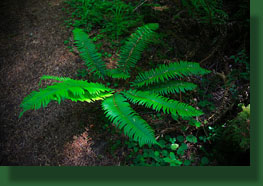
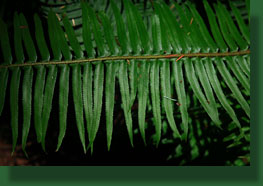
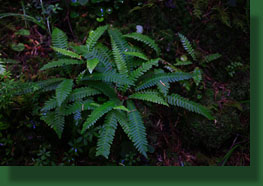
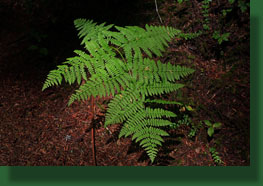
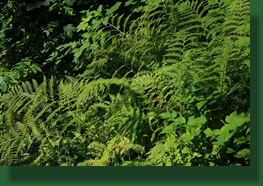
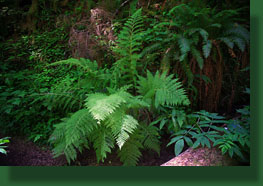
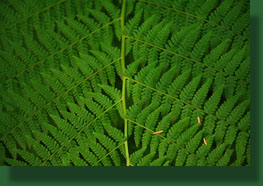
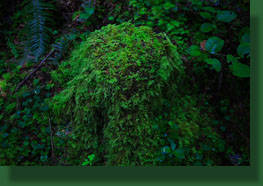
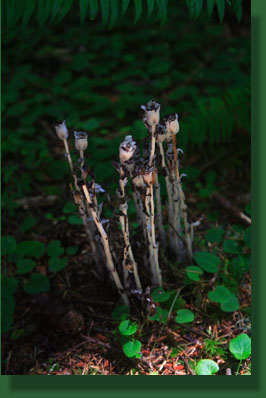
|
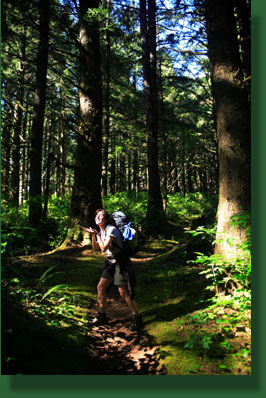
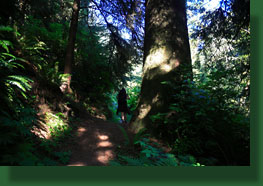

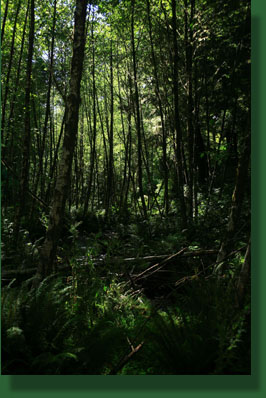
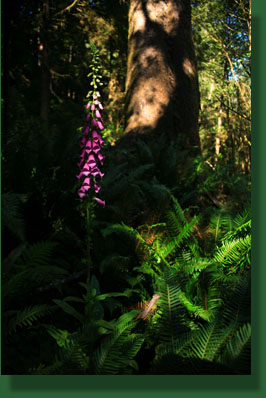
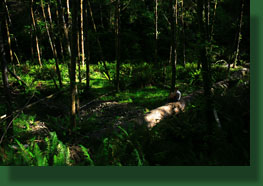
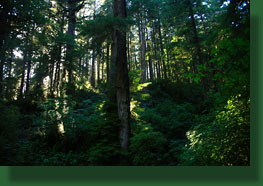
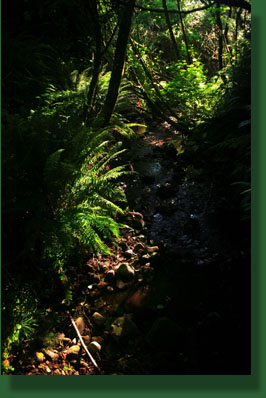
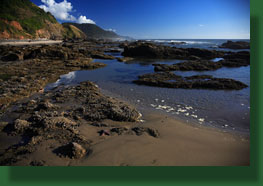
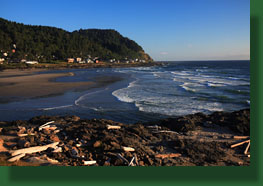
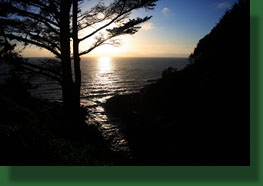
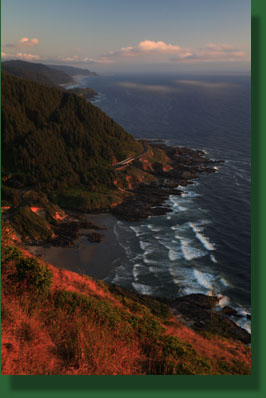
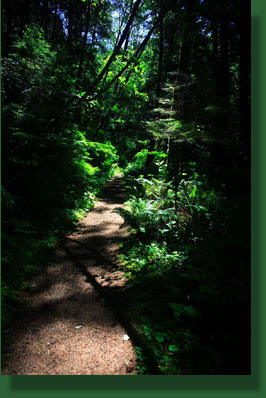
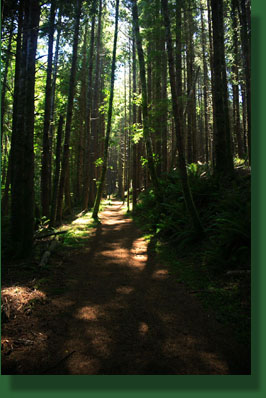
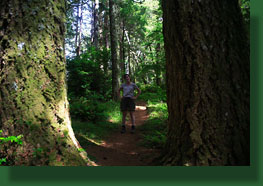
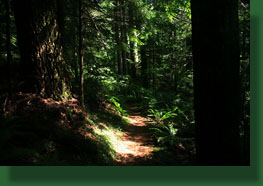
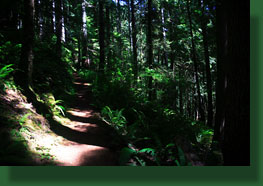
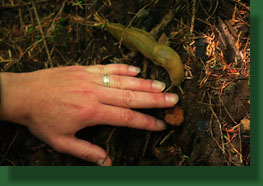
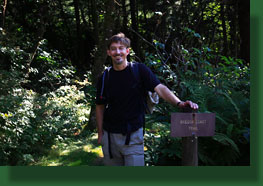 |


